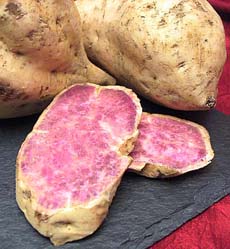 Want something new and exciting for dinner? Try these lavender Okinawa sweet potatoes...or the dozens of other exotic and heirloom vegetables we present for your consideration. Photo courtesy of Melissas.com. Want something new and exciting for dinner? Try these lavender Okinawa sweet potatoes...or the dozens of other exotic and heirloom vegetables we present for your consideration. Photo courtesy of Melissas.com.
|
ELIZABET TRAVIS is an Editorial Intern at THE NIBBLE.
|
|
July 2008 |
 |
Product Reviews / Main Nibbles / Vegetables
A Glossary Of Exotic & Heirloom Vegetables
Page 1: Overview
CAPSULE REPORT: This is Page 1 of a 15-page glossary of a glossary of exotic and heirloom vegetables. There’s lots to discover, and we provide sources where you can buy them all! Click on the black links below to see other pages.
Overview
Nearly all of us have enjoyed a baked potato and string beans at one time or another, but how many people can say they’ve tried the Peruvian purple potato or Chinese long bean, their more exotic relatives? Exotic and heirloom vegetables are much friendlier in flavor and in cooking methods than many people believe, and more accessible thanks to online ordering. In other countries (and in prior periods in U.S. history), these vegetables are as common as carrots; and even carrots will surprise you with their diversity
First, what’s the difference between an exotic vegetable versus an heirloom? It’s basically just origin versus age.
- In order for a vegetable to be considered exotic, it must be of foreign origin.
- An heirloom vegetable can come from the U.S., but it must not be grown through small-scale farming, not modern large-scale agricultural operations. An heirloom vegetable is also defined by its age, having been grown, and possibly been popular, during earlier periods in history.
- In addition, heirlooms must be open-pollinated cultivars. This distinguishes them from hybrid vegetables. Unlike hybrids, heirloom vegetables are “true to type,” which means they must be able to produce seeds that will result in a plant like their parents.
Why Seek Out Exotic & Heirloom Vegetables?
People grow exotic and heirloom vegetables for a variety of reasons. As the U.S. becomes more diverse, the demand for exotic foods grows. People want to eat and cook with the foods that are native to their birth country, whether it is China or Mexico. This has resulted in wider availability of exotic vegetables, and has also made growing these vegetables a lucrative and popular investment. A diner in the U.S. has the opportunity to eat cuisine from nearly every country and ethnic group in the world. The more exotic vegetables we grow here, fresher the better quality the food will be, and the more authentic our dining experiences will become.
Heirloom vegetables are rare and prized for their diversity of color and type. While big agriculture reduces vegetables to commodities, cross-breeding them down to varieties that ship, store, and look the prettiest on the shelf, much flavor is bred out in the process. In comparison, heirlooms are grown in a wide variety of breeds and are considered to deliver the best, most authentic flavor.
The widespread introduction of hybrid vegetables began in 1951, so it’s generally accepted that a vegetable must have been grown before then to be considered heirloom. Heirlooms that are kept local typically adapt over time to their climate and soil to become resistant to local pests, diseases and weather extremes. Similarly, moving a thriving heirloom plant from one locale to another may meet with less successful results. Thus, different areas of the country provide different bounties of heirloom vegetables. Visit farmers markets when you travel, and enjoy the discoveries.
Continue To Page 2: Finding & Cooking Exotic & Heirloom Vegetables
Go To Article Index Above
© Copyright 2005-2025 Lifestyle Direct Direct, Inc. All rights reserved. Images are the copyright of their respective owners.

|




